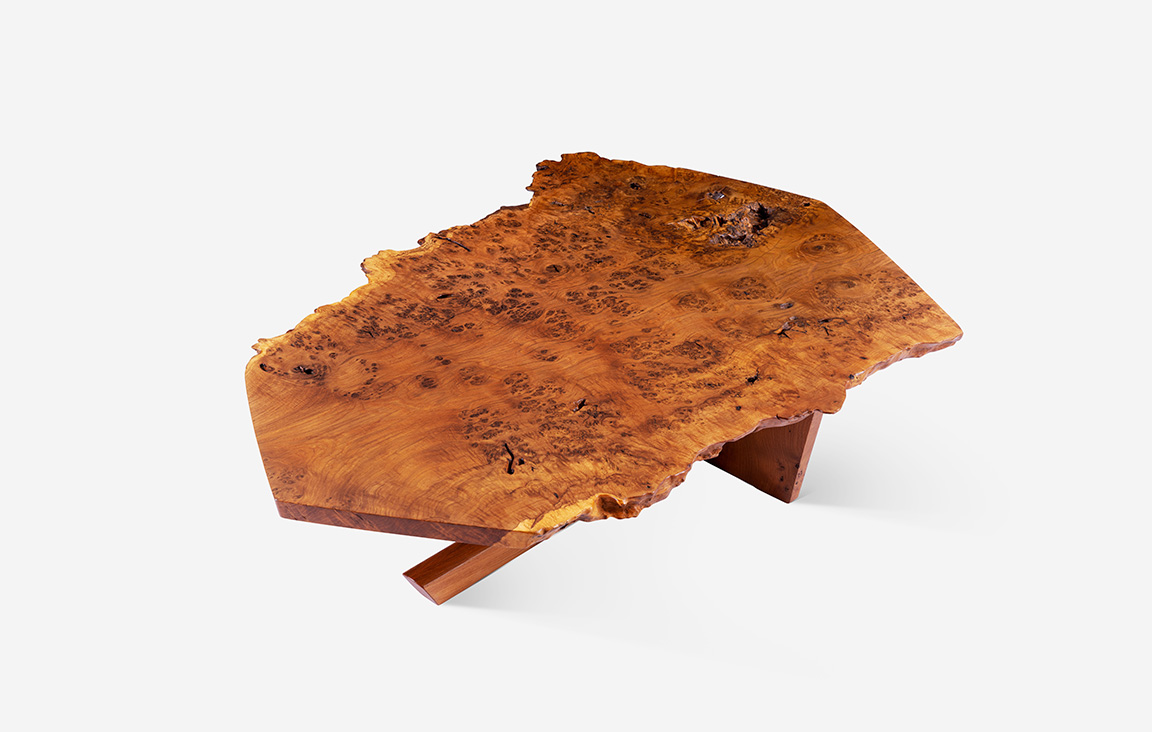No products in the cart.
5 Features That Make a Nakashima Coffee Table So Memorable
- October 27, 2023
- -
Do you recognize a George Nakashima coffee table when you see it? Are you sure?
As the father of the American Studio Craft Movement, Nakashima is commonly copied. A recent global surge in demand for live-edge wood furniture only reinforces the legacy of Nakashima’s iconic style.
Here are five features that make Nakashima’s tables so unique and memorable.
1. Perfect Imperfections
Nakashima found inspiration from traveling the world in the 1930s and ‘40s and revered the natural beauty of imperfect materials. He carefully hand-selected rough log scraps and offcuts that would have otherwise been discarded due to their knots and burls.
Using painstaking woodworking techniques, he refined these boards into astoundingly beautiful furniture. His pieces display characteristic oddities, elegance, charm, and timelessness. Each Nakashima coffee table is an original that can never be replicated.
Don’t be fooled by today’s mass-manufactured wood and live-edge tables. Although they might be beautiful in their own ways, these newly produced pieces are mere shadows of the classic Nakashima style.
2. The Nakashima Joint
Many Nakashima coffee tables have his namesake joint style, the Nakashima joint. Also known as a butterfly joint, bow tie joint, Dutchman joint, or dovetail key, it’s a type of winged inlaid joinery that brings together two disparate pieces of wood.
To create the joint, Nakashima cut a bow tie shape into the area where two pieces of wood needed to join, then inlaid a piece of identically-shaped wood into the space. This type of joint firmly connects two pieces while providing an aesthetically pleasing butterfly shape.
The Nakashima joint was the ideal method of combining his odd and asymmetrical wood choices into exquisite works of art. Nakashima perfected the technique while working with Japanese carpenter Gentaro Hikogawa in an internment camp during World War II.
Nakashima made these joints only with wood – usually offcuts from the same design, or sometimes wood scraps he saved in his studio. Any joint with inlaid metal or other materials is highly unlikely to be a Nakashima original.
3. Modernist Influences
Look closely at a Nakashima coffee table and you’ll see some classic signs of modernism: functionality, sleek lines, and minimal ornamentation. Nakashima felt a deep sense of inspiration from the work of Frank Lloyd Wright and Wright’s protégé Antonin Raymond. He also worked for Raymond in Japan in the 1930s.
Nakashima’s modernist influence extended beyond his designs and into his personal belief system. During a 1937 trip to India, Nakashima toured India’s first modernist building, the Sri Aurobindo Ashram, considered an outstanding example of harmony and humility in architectural design.
Nakashima was so deeply affected by the location’s spiritual significance that he joined the Ashram. Leader Sri Aurobindo gave him the Sanskrit name Sundarananda, meaning “one who delights in beauty.”
4. Bookmatched Timber
Many, but not all, Nakashima coffee tables incorporate bookmatched timber. Bookmatched boards come from cutting logs sequentially during lumber processing. The boards are numbered and stored together, then are matched end-to-end, side by side, or perpendicularly in the finished furniture.
After bookmatched boards are opened and joined, they give a mirrored or waterfall effect. Nakashima preferred this look to the “dull and uninteresting” look of other furniture and often incorporated up to six sequential boards in the same table.
Bookmatching is a simple but painstaking process because boards must be tracked and integrated with care. Nakashima conducted his bookmatching instinctually by spending hours in quiet contemplation with logs and slabs to understand their inherent beauty, only making cuts precisely when and where necessary.
5. Signed Nakashima Boards
While most custom furniture makers finish by signing their pieces with their names, Nakashima rarely did so. Instead, he signed a board with the client’s name, which typically ended up on the underside of the piece.
These signed boards are a key factor in establishing the heritage of Nakashima furniture. To understand why they’re so important, imagine Nakashima and his client hand-selecting timber together in a lumber yard or his workshop. Upon choosing just the right piece, Nakashima marked it with the date and his client’s name in simple black marker. The signed board is evidence of his artistic process and dedication to designing with his individual clients in mind.
Unless you’re lucky enough to have an original order card or shop drawing, a marked Nakashima board is considered an essential identifier. If the authenticity of a piece is ever in question, contact a qualified Nakashima furniture appraiser or gallery owner who handles American Studio Craft Movement pieces.
George Nakashima Coffee Tables
Some of the very best pieces of George Nakashima are his coffee tables. Here are a few of his finest coffee tables recently held by Moderne Gallery.

Nakashima Coffee Tables at Philadelphia’s Moderne Gallery
View and purchase the finest examples of Nakashima coffee tables at Philadelphia’s Moderne Gallery. The gallery is a global thought leader in the Studio Craft Movement with extensive expertise in identifying and honoring the works of George Nakashima.
Join Our Mailing List: Get the latest news, exclusive fair previews, and special access to new acquisitions.
We respect your privacy and promise to only send you the best content.
